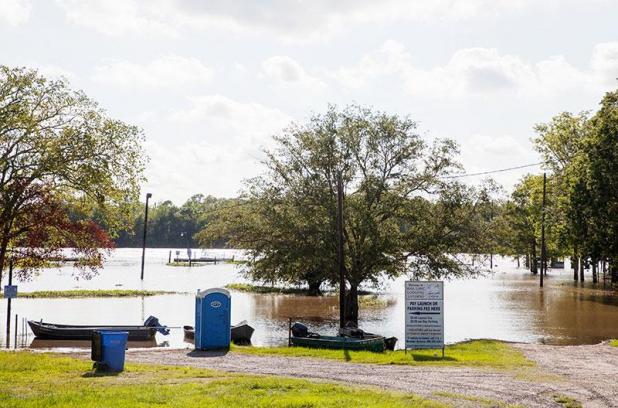
The Wax Lake Landing, along the Wax Lake Outlet (Calumet Spillway) remains flooded (Submitted Photo/Courtesy of John K. Flores)
What does flooding mean to St. Mary Parish fishery?
It’s hard to imagine what the indigenous people of ancient Louisiana must have felt emotionally while experiencing a high-water event in the marshes and swamps of the Atchafalaya Basin and river deltas. It’s also possible that this presupposition is wrong. They may have been perfectly fine with spring flooding, never once considering it a calamity like we do.
During their time, there was no bottled-up Mississippi River system with levees stretching the full length of the Louisiana Purchase and her tributaries. Back then, water flowed southward forming the alluvial plain.
The idea of vast levees and river control structures like the Bonnet Carré and Morganza spillways, built in 1931 and 1954, respectively, were modern man’s notions. And though these magnificent advances have created near agriculture utopia and unimaginable wealth, there are years when progress comes with angst and heartache, as people recover from flood damage to their homes and property.
So, what does this year’s flood event mean to St. Mary Parish’s commercial fishing interests and the many sportsmen and women who wander our lakes and bayous? Moreover, what can they expect going forward the second half of the year?
For one thing, the impact of freshwater from the Bonnet Carré Spillway differs greatly from that of the Morganza, where fisheries are concerned.
Freshwater dumped into Lake Pontchartrain has devastating consequences in that saltwater ecosystem, Louisiana Department of Wildlife and Fisheries Biologist Manager Jeff Marx says. Commercial oyster, crab and shrimp industries all suffer, and, recreational saltwater fishing is impacted tremendously, Marx says.
By contrast, Marx says the Morganza is essentially putting freshwater in a system that is already freshwater.
“With the Atchafalaya, we see an increase of water on a yearly basis,” Marx said. “It’s the normal cycle of things – you see a two-month spike in the river each spring. It goes up and then it goes back down. Obviously, this year is extremely different. We’ve had high river stages since September and October of last year, and they just haven’t gone down.”
According to Marx, one of the things high water has impacted locally this year is the brown shrimp population. Normally, brown shrimp are present in the Vermilion Bay system during the spring, even though the water may be fresher because of the Wax Lake Outlet and Atchafalaya River. The natural flow of these two effluents is westerly through East and West Cote Blanche bays to Vermilion Bay.
However, in 2019, Marx says there has been a lack of recruitment of brown shrimp into this region, chiefly because the water has been so fresh this year, where essentially, they haven’t seen them.
Another commercially important organism this year is Gulf menhaden, where numbers appear to be way down.
“We usually see several tens of thousands of those animals in the spring, and we just haven’t seen that number,” Marx said. “We’ve seen a few – a few thousand – but not tens of thousands.”
“But the good thing is,” Marx continued, “those organisms, like brown shrimp and menhaden, can move. They’ll be offshore and a bunch will still survive to adulthood and will be able to reproduce. They’re life cycles are like that. Menhaden only live a few years and shrimp in most cases live one to one and a half years. They’re like a crop. They’re there and they’ll be able to reproduce.”
High, strong flowing water pushes the saltwater line a little bit further south Marx says. What that means to recreational saltwater anglers is in order to catch redfish and speckled trout, anglers are going to have to run farther and burn more gas to find these species of fish in tough times locally.
“Recreational fisheries have been sort of poor as well, because speckled trout and redfish don’t particularly care to be hanging out in water that’s below one part per thousand salinity. So, they move further offshore, of course. They stay where they’re comfortable. So do shrimp and so do menhaden,” Marx said.
If there’s been any consolation this spring, there’s been notable catches of catfish locally in the Atchafalaya River the past couple of months. Whether high or low water, there’s nothing quite like sitting on anchor beneath the bridges in Berwick Bay tight lining with not a care in the world as cars and trucks speed by getting to work.
I’ve got a feeling when those ancient indigenous people paddled the Atchafalaya River through Berwick Bay, they didn’t care, either. High water happens to be the natural order of things around these parts.
EDITOR'S NOTE: Flores is The Daily Review's Outdoor Writer.
